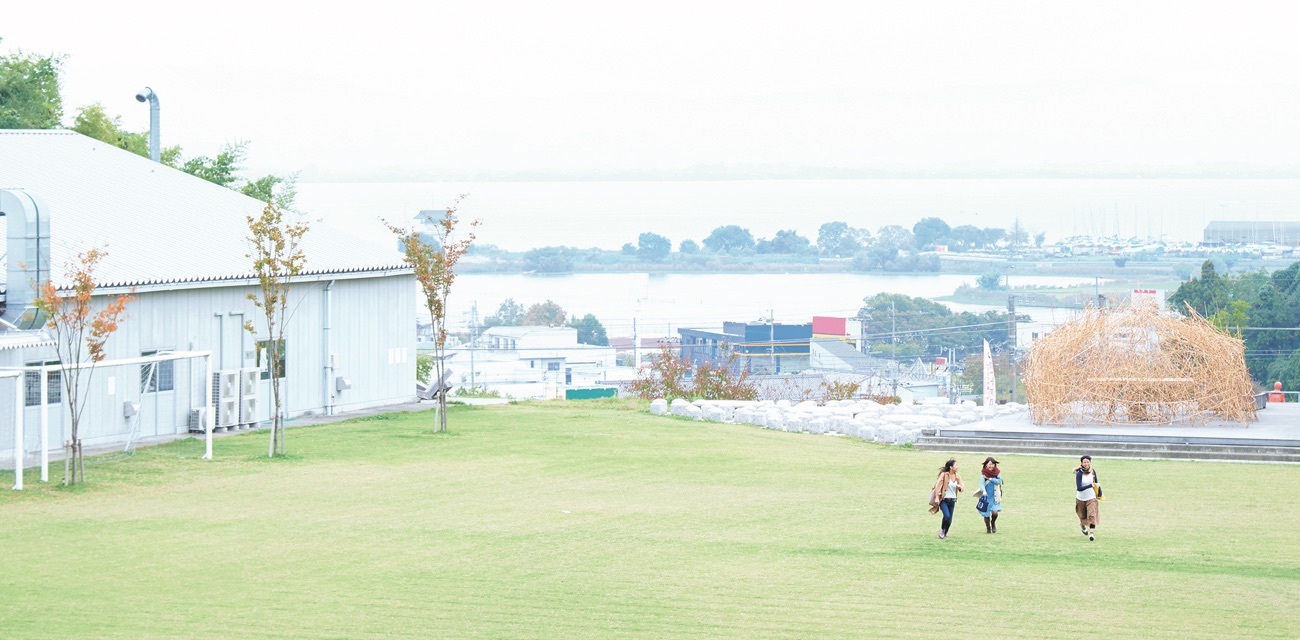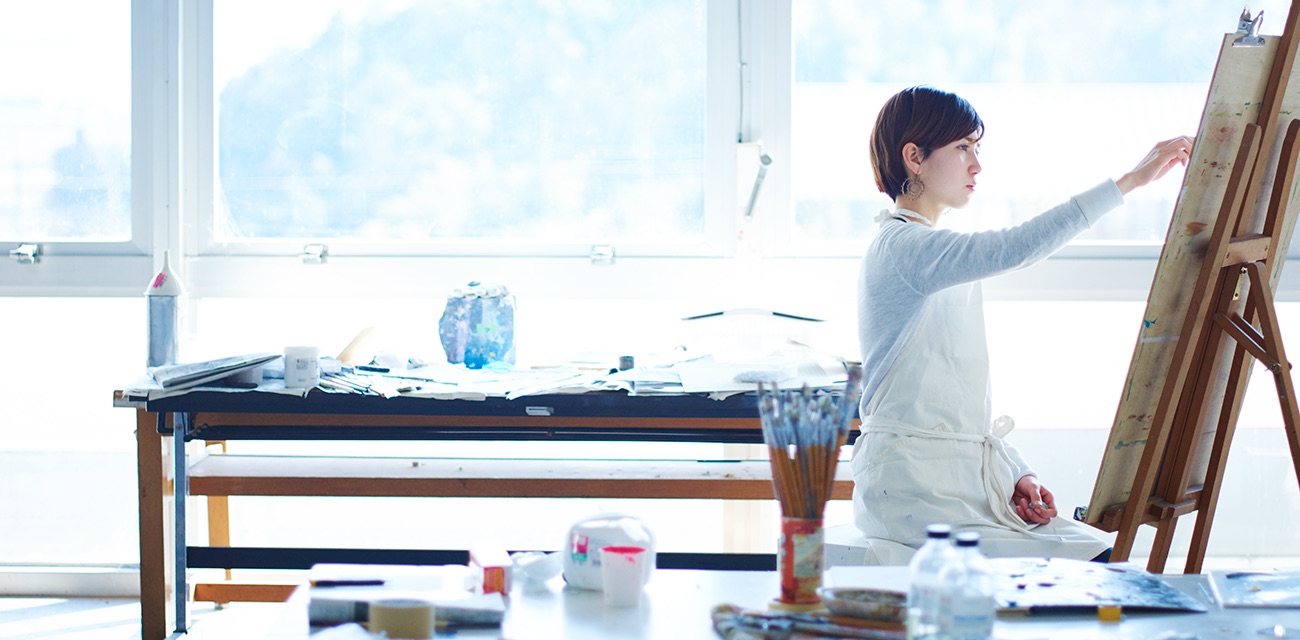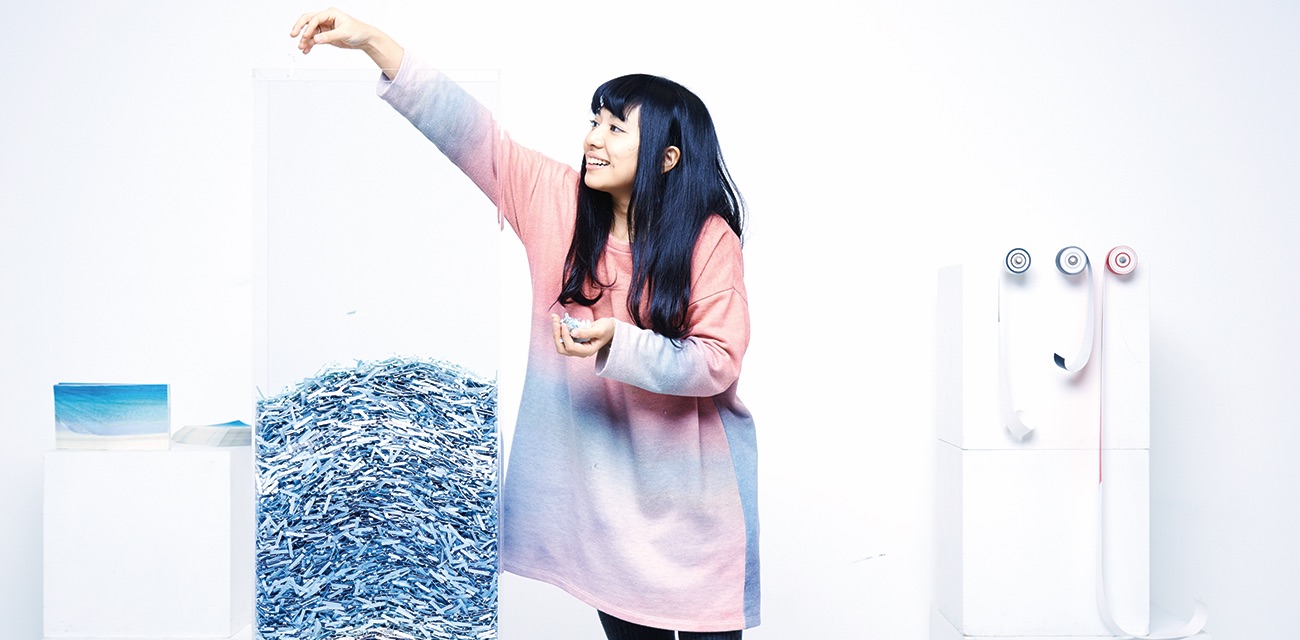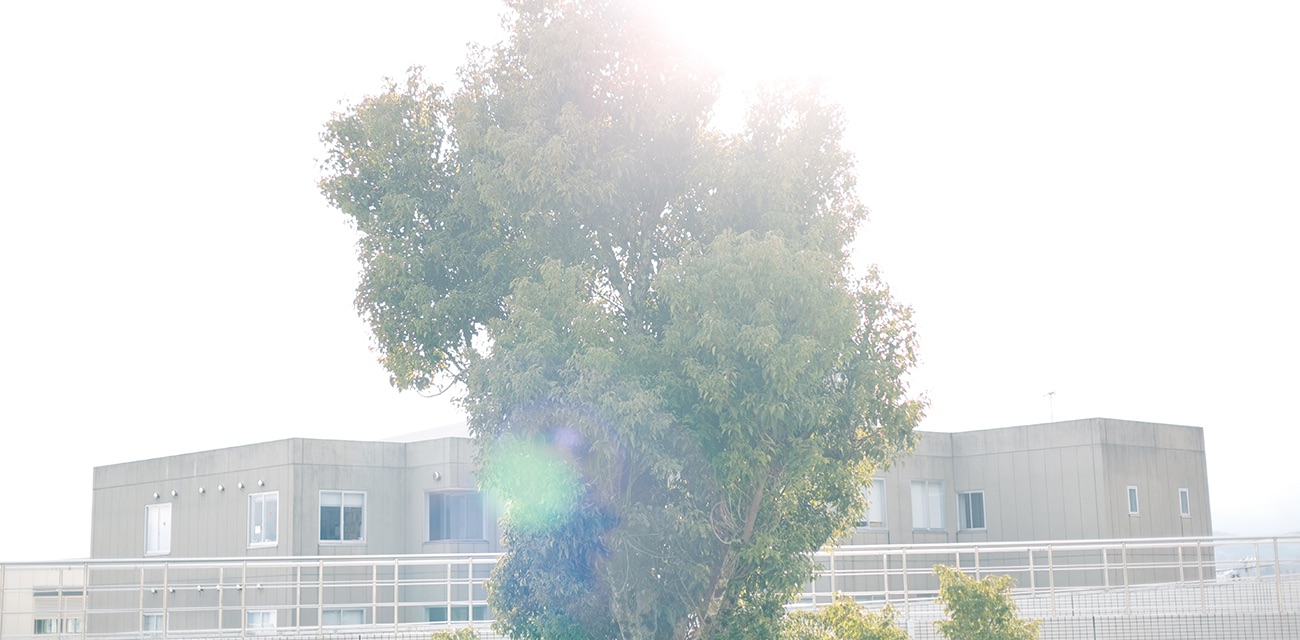※Information for 2026 will be released in July 2025.
About the University
Seian University of Art and Design, founded in 1993 and located in the city of Otsu in Shiga Prefecture, offers 16 four-year courses in the art and design field, provided through 6 departments focusing on a particular area or areas.
As illustrated by our small class sizes, we do our utmost to get to know all our students and treat them as individuals, and the atmosphere on the campus is very comfortable and friendly. Our three motivating concepts are "individual guidance," "learning that guarantees expertise," and "career support". Keeping these concepts in mind at all times, we attempt to help our students realize their individual objectives, thus enabling them to contribute to society through their art—all in a beautiful learning environment in the heart of Japanese nature.
We are also dedicated to bettering the regional cultural scene. This we do in various ways, such as cooperating with local governments, companies and all kinds of groups to give students opportunities to participate in society-wide projects. We also better the regional cultural scene through the Seian Art Center, known as "Campus ga Bijutsukan" (literally, Campus as an Art Museum), where art exhibitions are shown in our nine on-campus galleries, and through the Omi Multicultural Institute, which researches and communicates information about the history and culture of the surrounding region of Shiga Prefecture.
Chairman, Board of Trustees: YAMADA Takashi
President: OZAKI Yoshiyuki
“Contributing to society through art”
6 Departments | 16 Courses
Integrated Studies Department
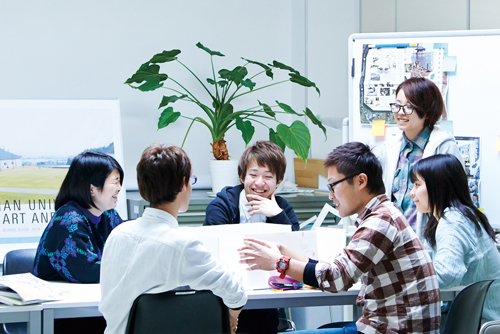
Learning how to employ design thinking to solve problems
Knowing how to employ design thinking is essential in order to discover new concepts, make proposals, and find solutions for issues that affect society. The Integrated Studies Department teaches students how to employ design thinking by providing them with opportunities to learn firsthand about the design process. Students become proficient at investigating issues, identifying problems, and coming up with ingenious answers, then turning those answers into concrete, workable solutions, and trying them out. The Integrated Studies Department teaches a good balance of areas covering knowledge, hands-on skills, and data proficiency, and hones students’ plan proposal, production, and direction skills through the use of their design expertise. It nurtures individuals with highly creative, well-rounded capabilities.
Comprehensive Design Course
Develop a broad perspective and acquire a comprehensive, cross-disciplinary education with an emphasis on design in general instead of focusing on specific specialized fields. Learn production and direction skills.
Illustration Department

Create and develop your own unique style of illustration and gain specialized knowledge through a curriculum that offers four different courses with a wide array of electives.
An illustration is a drawing or figure—usually intended to be reproduced—designed for explaining something or conveying information. Vital for print media, websites, advertisements, manga, animation, merchandise, and many other products and services, illustration is used in a broad range of areas today. As pop culture, it reaches deep into every corner of our lives.
Seian University of Art and Design has a long history of illustration education and has established its own unique curriculum. While building expertise through your own specialist course, you can also take classes from the other courses and choose from a wide variety of electives to create a personalized curriculum.
Media Illustration
Illustrations have historically been pictures or diagrams that functioned as design elements, printed in combination with text on pages. In this course you will learn to create artwork for stories that will bring them to life, eye-catching illustrations for striking cover pages and advertisements, as well as practical illustrations that supplement explanations and convey information effectively.
Character Creation
Characters were originally no more than a part of the stories in manga or anime, but today they have gained additional functions, such as advertising characters and virtual idols, becoming a familiar presence in many areas of everyday life. Through this course, you can learn to create your own world, along with the characters that inhabit it and the stories that take place in it.
3DCG and Animation
Animation and computer games now have vast numbers of fans around the globe, promising a bright future for the next generation of creators. In this course you will learn the techniques of both hand-drawn animation and three-dimensional computer graphics, and cultivate your skills to become a creator ready to shine in areas such as movies, TV, and games.
Illustration Art
This course provides ample opportunities to work with diverse themes, interpret and re-interpret them, and express them on your drawing surface, enabling you to gradually build your own unique creative concepts and establish your own style, with the aim of achieving artistic independence. In addition, you will have the chance to consider and experience various ways of getting your artwork known to the world, such as holding an actual exhibition of your work, publishing in print, and making use of digital space.
Fine Arts Department

Becoming expressive individuals who can contribute to society and foster diversity through art
Creating art involves developing a deep understanding of your topic, conceiving a new idea, trying out many different materials and techniques, and, finally, sharing with the world original work that leaves people moved. Painters and other artists aren’t the only ones expected to have these skills that are fostered by this process of creating art. They are important skills required in various situations in modern society, which demands that all people be able to express themselves The Fine Arts Department nurtures expressive individuals who can interact with people with diverse values and work in creative ways in society while possessing their own views.
Japanese-style Painting Course
Take a look at a variety of natural phenomena such as plants, animals, people and landscapes and, after acquiring the rudimentary skills, explore Japanese-style painting (Nihonga) more thoroughly through investigations into its history, materials and techniques. Find your own unique style of expression to take with you into the world.
Painting Course
After mastering basic techniques, learn about the specialist processes, techniques and materials used in Western-style painting, and widen your toolset of expressive techniques. With the help of thorough one-to-one guidance, decide on a research theme to pursue through both theory and practice, and develop the means to get your works out into the world.
Contemporary Art Course
As well as imparting the fundamental skills needed, this course will also allow you to experiment with a wide variety of materials, techniques, and media. Through projects encouraging interpersonal communication and involvement with the public, you will learn to arrive at a way of producing your own unique style of art, unconstrained by the traditions of conventional painting and sculpture.
Media Design Department

Viewing information from a design perspective and exploring forms of artistic communication that open up a new generation
Today, when everyone and everything is connected to networks, and the relationship between people, society, and information has become more important than ever, society’s design needs have undergone major changes. At the Media Design Department, students acquire expert knowledge and skills in four courses, and also have the opportunity to engage in cross-disciplinary studies in other courses. In this way they develop the flexibility to come up with ideas, to create, and to propose solutions in order to be able to adapt to changing information environments. After graduating, paths towards positions in a wide range of occupations in creative industries—including jobs as photographers, video artists, and art educators—open up for students, starting with design jobs working in planning, development, design, and advertising for corporate products and services.
Graphic Design Course
Learn about all aspects of the graphic design industry, and discover the forms of design that appeal to you. This course also offers many opportunities to learn firsthand about design as it takes place in the real world, such as participating in collaborative projects involving businesses and the public sector, and entering competitions within and outside the university.
Media Design Course
Study both visual expression and information systems, and explore new relationships between the individual and society. Master design skills and technologies for interactive media involving smartphone apps, digital signage, audiovisual, Virtual Reality (VR), and Internet of Things (IoT).
Photography Course
In addition to learning those skills directly related to photography, such as techniques for analogue and digital cameras, lighting techniques and so on students will also acquire a broader skill set including knowing how to come up with ideas for their photographs, and planning and holding photography exhibitions.
Video and Film Course
Master the basics such as filming, editing and sound design, as well as planning, scenario creation and animation techniques. Discover and explore the topics that really interest you, and learn the skills necessary to get these out to society.
Spatial Design Department

Turning proposals into reality through the study of spatial design from the perspective of clothing, objects, and living spaces
The study of spatial design relates to a broad range of things in our everyday lives, including clothing, everyday items, textiles, furniture, interior design, and homes. Students proceed through specialist courses in costume design, product design and living space design, which influence each other and give students a variety of different perspectives. By studying about the world and obtaining the ability to turn ideas into reality, students gain the ability to create designs in fields related to everyday life.
Costume Design Course
Students of this course will learn the techniques and theories that form the basis of costume design, as well as how to create artistic pieces using wood and resin. Acquire skills useful across the fashion industry, and pursue an artistic approach to costume design.
Product Design Course
Learn about the design of objects such as everyday items, furniture, cars, appliances and public sector systems that make our lives easier and shape our future. Students hone their abilities to identify gaps in the market from their own personal experience or social observation, and create design solutions.
Living Space Design Course
Acquire the technical skills to accurately depict spaces and forms. Students will develop the imaginative and expressive abilities necessary to design attractive spaces that take into consideration the surrounding environment; learn about architecture, interior design, and landscape gardening; and formulate designs for living spaces that produce a feeling of well-being.
Creative Community Department

Acquiring the ability to produce creative proposals as key members of the community
As Japan’s population decreases, revitalization of regional areas is the most important factor that comes to mind when trying to envision a sustainable society. The purpose of the Creative Community Department is to foster individuals who contribute to the enhancement of creativity in the local community, reinterpreting art from a local perspective. The department offers a four-year curriculum, using as a base Omi Studies and the Regional Collaboration Program developed by the university. Leveraging the special characteristics of Seian University of Art and Design’s approach to art education, the system allows students to learn by assimilating into the local community in a more concrete way, with active members of the community acting as instructors.
Creative Studies Course
Experience Seian University of Art and Design’s unique education system, which takes advantage of the wonderful environment and qualities of Shiga Prefecture. Through practical education in the field, consider the shape of future society, and acquire the ability to conduct research, come up with ideas, and discover and resolve problems, while developing the creativity needed to open up a new future.
Interviews
Interview with Seian graduate Jinn Swatthanakoon from Ratcha Anachak Thailand
(Class of 2015 Spatial Design Department) [4:33]
* This interview is in Thai
Interview with Seian graduate Triandhika Anjani from the Republic of Indonesia
(Class of 2015 Illustration Department) [3:09]
* This interview is in Indonesian
Interview with Seian graduate Shaye Schumaker from the USA
(Class of 2015 Media Design Department) [3:24]
* This interview is in English
Policy
Admission Policy
Seian University of Art and Design seeks students who respect the legacy of the school's guiding principles and philosophy of education, and who possess the following scholastic ability and qualities required to live up to the school’s Diploma Policy.
Has acquired an education in high school or the equivalent that fostered in the applicant the three elements of scholastic ability—a) knowledge and skills, b) the ability to think, exercise good judgment, and express oneself, and c) an attitude that enables him/her to learn while acting independently, but also while collaborating with people from a broad range of backgrounds and experience.
Is motivated to take advantage of his/her specialist field and make practical use of it in society.
Is motivated to develop his/her creativity.
Those who strive to make the most of the university’s unique education system, Seian Personal Program (SPP), throughout their studies
Is motivated to collaborate with others in order to follow through on issues.
Is motivated to formulate goals and act independently.
Diploma Policy
Grounded in a foundation of guiding principles and philosophy of education that are the legacy of this institution, Seian University of Art and Design nurtures individuals who excel in expertise and creativity in their artistic fields, and who are capable of thinking and acting independently in contributing to a better society. With this objective in mind, the university confers degrees upon students who have completed the designated courses and fulfilled 124 academic credits and other requirements, and who have acquired the following qualities and abilities.
Is able to make the most of his/her specialist field and make practical use of it in society.
Applies the knowledge, skills, and proper attitude acquired through the creation of works in his/her specialist field in presenting his/her results.
Is able to properly understand issues, formulate solutions, and carry them out.
Is able to deepen his/her understanding of diversity, work with others, and contribute to the group and society.
Has clear goals and strives towards achieving them while demonstrating sincerity, passion, and self-control.
Curriculum Policy
In order to achieve the goals outlined in the Diploma Policy, the curriculum is organized based on the following policies.
- 1. A curriculum with a clear progression is established to help students develop practical competence, creativity, and the ability to solve problems, collaborate, and act independently in the field of art.
- 2. The curriculum is divided into three stages as follows: Introduction to Specialty, covered in the first year; Core Specialty, covered in the second and third years; and Specialist Research, covered in the fourth year. A student’s four-year course of study is made up of two kinds of curricula: Specialist Curriculum and Common Studies Curriculum.
- 3. Scholastic achievement is evaluated fairly based on the extent to which students achieve the curriculum objectives set out in each subject. Students are screened before progressing to the Specialist Research stage to determine whether they have the ability to conduct research independently.
- 4. The curriculum is carefully designed and used to provide subjects that develop the general, basic skills (the ability to collaborate and act independently) and problem-solving skills necessary to pursue future studies, and that establish creativity and practical competence that is integrally linked to knowledge of the specialist area studied.
- a. The Specialist Curriculum is studied in three stages: Introduction to Specialty, Core Specialty, and Specialist Research. In the Introduction to Specialty stage, students acquire the key knowledge and techniques necessary to pursue the Specialist Curriculum through a series of practical training classes and lectures. In the Core Specialty section, students acquire the techniques and knowledge that will form the cornerstone of expert knowledge, and take practical training classes and lectures needed in order to acquire a deep and profound grasp of their chosen specialty. In the Specialist Research stage, students will broaden and refine their knowledge and techniques relating to their own specialty. Through seminars and electives, they will improve their ability to express themselves and think autonomously, learn to independently conduct autonomous research, deepen their grasp of their chosen specialty, and complete their graduation research.
- b. The Common Studies Curriculum, which provides a broad-ranging education that supports students’ Specialist Curriculum studies as well as the course of their future careers, consists of four main pillars: Core Subjects, the Practical Subjects Group, the General Studies Group, and the Social Contribution Group. The Core Subjects Group includes 1) the Starter Programs designed to give students the basic skills required to ensure that they can progress through their four years at university smoothly and independently; 2) the Introduction to Art Subjects that cover fundamental art theory, thereby supporting a wide range of artistic creation; and 3) the Foundation Subjects that provide students with a broad base of artistic capacities.
The Practical Subjects Group offers students theoretical and practical support in a wide range of different artistic activities, helping instill the expert knowledge and techniques considered necessary for the Core Specialty Curriculum and Specialist Research Curriculum.
The General Studies Group includes cultural subjects that encourage students to interpret works of art from various perspectives and foreign language subjects that give students the skills to communicate with those from other cultures. It is also possible to take subjects offered in other universities and colleges that have agreed to a credit exchange system with Seian University of Art and Design.
The Social Contribution Subjects Group offers students the chance to learn about themselves through interaction with and contribution to society, and thus to improve their ability to achieve their goals after graduation. The local contribution projects develop problem-solving skills through practical education in local communities. The Career Design Curriculum helps students design their career, and formulate the career path that is best suited to them through step-by-step learning.
Admission
There are three entrance exam systems.
(1)Special Comprehensive Selection Entrance Examination (Exam 1) (Exam 2) (Exam 3) Interview-based for International Students, Returnees, and Working Adults
[Dates/times]
| Pre-application period | Examination date | |
|---|---|---|
| Special Comprehensive Selection Entrance Examination (Exam 1) Interview-based For International Students, Returnees, and Working Adults |
Aug. 25 to Sep. 3 Internet registration|Deadline: 11:59 p.m. Submitted documents must arrive by deadline |
Interview Sep. 17 (Tue.) |
| Special Comprehensive Selection Entrance Examination (Exam 2) Interview-based For International Students, Returnees, and Working Adults |
Sep. 13 to Sep. 27 Internet registration|Deadline: 11:59 p.m. Submitted documents must arrive by deadline |
Interview Oct. 6 (Sun.) |
| Special Comprehensive Selection Entrance Examination (Exam 3) Interview-based For International Students, Returnees, and Working Adults |
Nov. 18 to Nov. 22 Internet registration|Deadline: 11:59 p.m. Submitted documents must arrive by deadline |
Interview Nov. 30 (Sat.) *Alternative examination date: Dec. 1 (Sun.) |
- For Exam 3, if there are too many applicants to conduct all interviews on the same day, interviews will also be conducted on the alternative examination date.
Applicants will be informed of their interview date on their pre-application reception card. - Please read the section in the 2025 Enrollment Guide on the Comprehensive Selection Entrance Examination (P51).
- Exam 1 and Exam 2 are for "sengan" applications (meaning that once you submit your formal application, you must agree to apply to this school only).
- The documents that must be submitted for pre-applications and applications are indicated on P47 of the 2025 Enrollment Guide.
Examination subjects, time, and total possible score
- See P50 of the 2025 Enrollment Guide for examination content and grading standards.
Integrated Studies, Illustration, Fine Arts, Media Design, and Spatial Design Departments
| Examination subject | Examination time | Total possible score |
|---|---|---|
| Portfolio review + individual interview (Interviews last roughly 20 minutes per person) |
Begins at 10:00 a.m. | 100 |
- The time you must arrive by on the day of the examination will be indicated on the pre-application reception card.
Creative Community (Select One Of The Following Examination Subjects)
| Examination subject | Examination time | Total possible score |
|---|---|---|
| Portfolio review + individual interview (Interviews last roughly 20 minutes per person) |
Begins at 10:00 a.m. | 100 |
| Presentation of three objects to introduce applicant's hometown + individual interview (Interviews last roughly 20 minutes per person) |
Begins at 10:00 a.m. | 100 |
- The time you must arrive by on the day of the examination will be indicated on the pre-application reception card.
- Examples of objects applicants can use to introduce their hometown: specialty products, printed materials/photographs, objects from nature, etc.

For further details, consult the PDF 2025 Enrollment Guide (12.1MB, Japanese language only)
(2)Special Comprehensive Selection Entrance Examination (Exam 4) Scholarship Student Practical Examination
[Dates/times]
| Pre-application period | Examination date |
|---|---|
| Oct. 25 to Nov. 8 Internet registration | Deadline: 11:59 p.m. |
Practical Examination Nov. 16 (Sat.) |
This examination is used to select examinees with exceptional practical examination results as scholarship students.
Examination subjects, time, and total possible score
- See P50 of the 2025 Enrollment Guide for examination content and grading standards.
| Examination subject | Examination time | Total possible score |
|---|---|---|
| Pencil drawing | Doors open: 10:40 a.m. Assemble by: 11:40 a.m. Examination: 12:00 p.m. to 4:30 p.m. |
100 |
Examination sites
Main campus site: Seian University of Art and Design
Kanazawa site: Ishikawa Prefecture Workers' Welfare and Culture Center (Friend Park Ishikawa)
Okayama site: Dai-ichi Central Building 1
- See P49 of the 2025 Enrollment Guide for details regarding examination sites.
Entrance examination task and publicly disclosed subject matter (see P71 of the 2025 Enrollment Guide)
Pencil drawing (270 minutes)
Freely arrange and draw the following subject matter on the examination sheet (a 19 x 13 cm sheet of drawing paper).
[Subject matter]
- Newspaper (Asahi Shimbun, morning edition, the date of issue will vary)
- Carbonated beverage (1.5 liter bottle of Sprite (Coca-Cola (Japan) Company, Limited))
- Two apples
- Bell pepper
- The exact subject matter may vary depending on when the products are sold. Printed content, shapes, sizes, (including label sizes and lengths), may also vary. Under extenuating circumstances, similar items may be used instead.
-
[Note 1]Applicants may position the examination sheet horizontally or vertically.
-
[Note 2]Applicants must draw all of the provided subject matter.
-
[Note 3]Implements brought to the examination may only be used for their intended purposes.
-
[Note 4]One rough sketch page may be used to roughly sketch the arrangement, etc.
-
[Note 5]Applicants may not open the carbonated beverage.

For further details, consult the PDF 2025 Enrollment Guide (12.1MB, Japanese language only)
(3)General Selection Entrance Examination (Exam 1) (Exam 2) Interview-based & Practical Examination
General Selection Entrance Examination (Exam 1) (Exam 2) Interview-based & Practical Examination for International Students
General Selection Entrance Examination (Exam 1) (Exam 2) Interview-based & Practical Examination for International Students
[Dates/times]
| Application period | Examination date | |
|---|---|---|
| General Selection Entrance Examination (Exam 1) Interview-based & Practical Examination | Jan. 6 to Jan. 22, 2025 Internet registration|Deadline: 11:59 p.m. Submitted documents must arrive by deadline |
Interview Feb. 1, 2025 (Sat.) Practical Examination Feb. 2, 2025 (Sun.) |
| General Selection Entrance Examination (Exam 1) Interview-based & Practical Examination for International Students | Jan. 6 to Jan. 22, 2025 Internet registration|Deadline: 11:59 p.m. Submitted documents must arrive by deadline |
Interview Feb. 1, 2025 (Sat.) Practical Examination Feb. 2, 2025 (Sun.) |
| General Selection Entrance Examination (Exam 2) Interview-based & Practical Examination | Feb. 3 to Feb. 14, 2025 Internet registration|Deadline: 11:59 p.m. Submitted documents must arrive by deadline |
Interview Feb. 21, 2025 (Fri.) Practical Examination |
| General Selection Entrance Examination (Exam 2) Interview-based & Practical Examination for International Students | Feb. 3 to Feb. 14, 2025 Internet registration|Deadline: 11:59 p.m. Submitted documents must arrive by deadline |
Interview Feb. 21, 2025 (Fri.) Practical Examination |
- Those wishing to apply using these examination methods cannot also apply using the [General Selection Entrance Examination (Exam 1) Scholarship Student Common Test for University Admissions Application Process (with Income Restrictions)], the [General Selection Entrance Examination Scholarship Student Practical Examination (with Income Restrictions)], or the [General Selection Entrance Examination (Exam 2) Common Test for University Admissions Application Process] examination methods, which are offered during the same submission period.
Examination subjects, time, and total possible score (select one of the following examination subjects)
- See P50 of the 2025 Enrollment Guide for examination content and grading standards.
Integrated Studies, Illustration, Fine Arts, Media Design, and Spatial Design Departments
| Examination subject | Examination time | Total possible score |
|---|---|---|
| Pencil drawing | Doors open: 10:40 a.m. Assemble by: 11:40 a.m. Examination: 12:00 p.m. to 4:00 p.m. |
100 |
| Portfolio review + individual interview (Interviews last roughly 20 minutes per person) | Begins at 10:00 a.m. | 100 |
- The time you must arrive by on the day of the examination will be indicated on the examination admission card.
Creative Community
| Examination subject | Examination time | Total possible score |
|---|---|---|
| Pencil drawing | Doors open: 10:40 a.m. Assemble by: 11:40 a.m. Examination: 12:00 p.m. to 4:00 p.m. |
100 |
| Portfolio review + individual interview (Interviews last roughly 20 minutes per person) | Begins at 10:00 a.m. | 100 |
| Presentation of three objects to introduce applicant's hometown + individual interview (Interviews last roughly 20 minutes per person) | Begins at 10:00 a.m. | 100 |
- The time you must arrive by on the day of the examination will be indicated on the examination admission card.
- Examples of objects applicants can use to introduce their hometown: specialty products, printed materials/photographs, objects from nature, etc.

For further details, consult the PDF 2025 Enrollment Guide (12.1MB, Japanese language only)
Application Requirements
Applicants must be non-Japanese citizens (excluding those who have permanent or long-term residence status in Japan), and must fulfill all of the following four criteria (1)–(4).
| (1) |
EITHER
|
||||||
|---|---|---|---|---|---|---|---|
| (2) |
EITHER
|
||||||
| (3) | Have passed level N2 or above of a Japanese-Language Proficiency Test (JLPT) taken since 2021 or have obtained a combined score of at least 220 on the reading comprehension and listening and listening-reading comprehension sections of the Japanese as a Foreign Language portion of the Examination for Japanese University Admission for International Students (EJU) by the time of the examination date. Alternative qualifications may be accepted in special circumstances. | ||||||
| (4) | Have sufficient Japanese ability to participate in classes held in Japanese upon enrollment. |
The pre-application (and exam) are free of charge.
Note that for the first and second exams, once you submit your formal application, you must agree to apply to this school only (the “sengan” system). Before submitting your formal application, you may apply to multiple schools.
Tuition Fee
| Department | Period | Enrollment Fee | Tuition Fee | Education Enrichment Fee | Other Expenses | Total |
|---|---|---|---|---|---|---|
| Integrated Studies Department | Full year | ¥200,000 | ¥980,000 | ¥182,500 ※ | ¥41,660 | ¥1,404,160 |
| Payable upon admission (first semester fees, etc.) | ¥200,000 | ¥490,000 | ¥91,250 | ¥41,660 | ¥822,910 |
| Department | Period | Enrollment Fee | Tuition Fee | Education Enrichment Fee | Other Expenses | Total | Creative Community Department | Full year | ¥200,000 | ¥900,000 | ¥62,500 ※ | ¥41,660 | ¥1,204,160 |
|---|---|---|---|---|---|---|
| Payable upon admission (first semester fees, etc.) | ¥200,000 | ¥450,000 | ¥31,250 | ¥41,660 | ¥722,910 |
| Department | Period | Enrollment Fee | Tuition Fee | Education Enrichment Fee | Other Expenses | Total |
|---|---|---|---|---|---|---|
| Illustration Department, Fine Arts Department, Media Design Department, Spatial Design Department | Full year | ¥200,000 | ¥1,540,000 | ¥62,500 ※ | ¥41,660 | ¥1,844,160 |
| Payable upon admission (first semester fees, etc.) | ¥200,000 | ¥770,400 | ¥31,250 | ¥41,660 | ¥1,042,910 |
[Students accepted as scholarship students]
| Benefit Category | Period | Enrollment Fee | Tuition Fee | Education Enrichment Fee | Other Expenses | Total |
|---|---|---|---|---|---|---|
| Scholarship student | Full year | ¥200,000 | ¥698,000 | Exempted | ¥41,660 | ¥939,660 |
| Upon enrollment (first semester) | ¥200,000 | ¥349,000 | Exempted | ¥41,660 | ¥590,660 |
Breakdown of Other Expenses
| Insurance for injuries from accidents / Insurance for accidents involving third parties or their property | Once only, at time of enrollment | ¥4,660 |
|---|---|---|
| Educational Support Association Enrollment Fee | Once only, at time of enrollment | ¥5,000 |
| Educational Support Association Membership Fee | Annual fee | ¥20,000 |
| Students’ Association Membership Fee | Annual fee | ¥10,000 |
| Department Orientation Activities Fee | Once only, at time of enrollment | ¥2,000 |
| Total | ¥41,660 | |
For further details, consult the PDF 2025 Enrollment Guide (12.1MB, Japanese language only)
Access & Contact Information
SEIAN UNIVERSITY OF ART AND DESIGN
4-3-1 Oginosato-higashi Otsu Shiga 520-0248 Japan
Admissions Office
From Kansai International Airport to Seian University of Art and Design

-
From Kansai International Airport(KIX) to Kyoto Station
Approx. 75 minutes by JR Airport Express HARUKA
OR
Approx. 85 minutes by limousine bus -
From Kyoto Station to Seian University of Art and Design
Approx. 20minutes by local train on the JR Kosei Line from Kyoto Station
Approx. 3 minutes on the school bus from Ogoto-Onsen Station
School Bus
A free shuttle bus runs between the JR Ogoto-Onsen Station and the university. Go out of the station and go east toward ticket gate and go toward Lake Biwa (Biwako). The bus leaves from in front of Shiga Bank (Shiga Ginko = 滋賀銀行) and takes approximately three minutes to reach the university.

